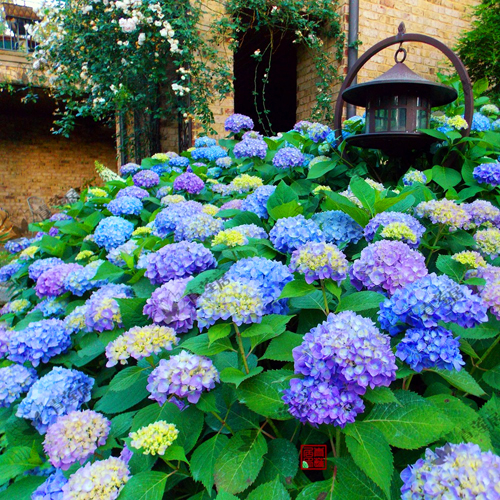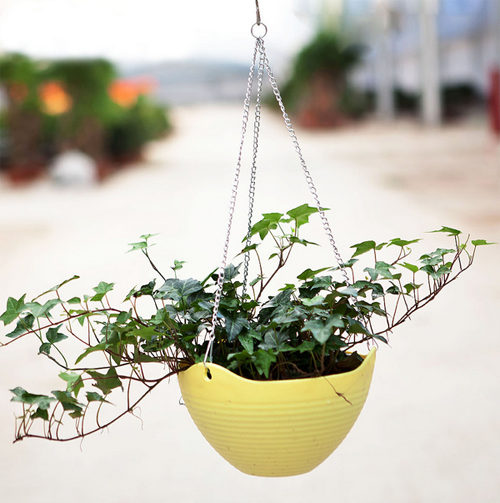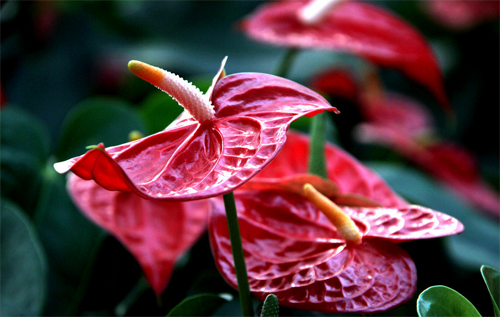Culture methods of hydrangea in endless summer color blending and pruning techniques
Endless summer is what we call hydrangea, which is often used in weddings. Most brides will choose endless summer to hold flowers in their hands. The flowers in endless summer are very large, like hydrangeas, so there is the saying that hydrangea flowers can be planted in endless summer. What are the techniques for color blending and trimming?

In late spring and early summer in May, blue or pink hydrangeas began to bloom one after another, but they were unexpectedly beautiful. Big flower hydrangea endless summer is unable to bear loneliness, a branch blooming early in the branch. The greasy "endless summer" is a variety of Hydrangea, belonging to Saxifragaceae and Hydrangea. The florescence is from June to September, hence the name because it can bloom beautiful flowers all summer.
The origin of endless summer:
As for the origin of "endless summer", it can be traced back to the mid-1980s, when the salesman of the Bailey nursery found a kind of hydrangea that could differentiate into flower buds on the shoots in a garden in Cotazhiroway, a suburb of St. Paul, Minnesota, but it did not attract people's attention at that time. Until 2003, Bailey nursery introduced this unique eight immortal flowers, named "endless summer", and applied for new variety protection.
The characteristics of endless summer:
The biggest difference between endless Summer and other kinds of hydrangea lies in the length of flowering period. Researchers at the University of Florida found that endless Summer blossoms an average of 10-12 weeks longer than ordinary hydrangeas, tolerates low temperatures better than ordinary hydrangeas, and blossoms in colder environments.
Farming methods in endless summer:
1. Planting location
The planting location of "endless summer" in the garden has the greatest impact on the bloom of its flowers. Hydrangea belongs to short-day plants, like warm, humid and semi-shady environment, but the number of flowers will be reduced when the light time is less than 2-3 hours a day. The best planting location is to be able to receive mottled light for at least six hours a day and avoid the wind.
two。 Fertilizer application
Fertilization is also a very important factor affecting the flowering of endless summer. In spring or early summer, seedlings planted in the ground should apply slow-release fertilizer of better quality, preferably with a NPK content of 10-40-10. Container-cultivated "endless summer" needs to add liquid fertilizer in the growing season, but it is not easy to apply too much fertilizer, otherwise it will result in more old leaves and fewer and fewer flower buds. When the plant growth slows down and prepares to hibernate, stop applying chemical fertilizer.
3. Watering
The amount of watering is also an important factor affecting flowering. Too much watering can easily cause rotten roots, but also cause more leaves, less flower buds, delayed flowering and so on. In particular, it should be noted that it is normal for plants to wilt at higher temperatures, and it is best not to water or water less, so as not to burn plants.
4. Winter cover
It is very important to protect "endless summer" in the first few years of planting. To ensure that plants survive the winter safely, keep the soil moist in autumn and stop watering when it freezes in winter. Before the "endless summer" fully dormant, it is necessary to cover the plant with sawdust and dead leaves to achieve the effect of keeping warm. But when covering, it is not necessary to cover the stem from the root to the stem tip.
Winter mulching can not only protect "endless summer" safely through the winter, but also prevent frost damage in spring. As the flower buds of "endless summer" appear in early spring, late freezing injury will damage the development of buds and the formation of new buds. Effective mulching can protect the growth and development of new buds and later stages. Remove the mulch in time when thawing in spring so as not to affect the budding and flowering of the old branches at the base.
Endless summer pruning:
Spring is the best time to prune "endless summer". It should be noted that, unlike ordinary hydrangeas, endless summer can blossom on both new and old branches, and flower buds can continue to bloom throughout the season. Experience has shown that it is best not to prune newly planted, smaller plants, because flower bud formation takes a long time. The plant that has been growing for many years is affected by low temperature in early spring, the plant will grow slowly, and the growth will accelerate rapidly with the rise of air temperature. when it is found that the new branches grow out, cut off the old branches at the place about 1cm from the base of the new branches. Removing residual flowers or picking flowers can promote the plant to produce more flowers. Many people like to cover the residual flowers at the base of the plant, which can enhance the plant's frost resistance and protect new buds from frost and low temperature, but should be removed in time in spring.
The colors of endless summer:
At the same time, "endless summer" has the characteristics of blooming flowers of different colors according to different soil acidity and alkalinity. Pink flowers will bloom in alkaline soil of pH 6.07.0.Blue flowers will bloom in acid soil of pH 5.05.8. For the plant to bloom in the desired color, lime and aluminum sulfate can be used to adjust the pH of the soil.
The application of endless summer:
For a long time, the eight Immortals has been deeply loved by growers for its huge flower balls and beautiful colors, and has been widely cultivated in courtyards and gardens. And "endless summer" undoubtedly provides a better choice for growers. The colorful flowers and long flowering period make the application market of "endless summer" in courtyards and gardens huge.
This is the end of the knowledge about endless summer. If you like, plant it in your own home as soon as possible.
Culture methods of hydrangea (environment, pruning, fertilization)
Some flower friends have a special preference for hydrangea, and do not dare to start rashly because they do not understand the breeding methods and matters needing attention of hydrangea. This paper introduces the maintenance of hydrangea from the planting environment, medium and flowerpot, pruning, fertilization, color blending and other links. This article is not theoretical knowledge, but the experience of flower friends, for those who like hydrangea, it is worth studying.
1. Planting environment
Hydrangea is a shade-tolerant plant, but that doesn't mean they don't like the sun. The same variety, in the environment of sufficient sunshine, the branches are stout, not easy to fall down, and the flowers are large and colorful. However, the shade tolerance of hydrangea is also a major feature of it. If the sunshine is less than an hour, it can also blossom, but the flowers may be slender and easy to fall down. The degree of softness and hardness of the branches is also related to the varieties. Some varieties are naturally drooping. These varieties can be planted in raised flower beds, allowing the branches to droop naturally and form a different appreciation angle. Sometimes, a disadvantage is an advantage.
The cold resistance of hydrangea is slightly worse than that of the rose. When the northern flower friend is below 10 degrees below zero, you should protect the old branches, otherwise the flowering branches of the old branches will be frostbitten, and there will be no way to blossom the next year. The picture below shows the blue mother in bloom.
2. Planting media and flowerpots
Hydrangea does not have high requirements for medium soil, but only needs slightly higher moisture retention. Because Hydrangea grows luxuriantly, starting in April, when water transpiration is fast, you must ensure that it is not dehydrated before the next watering, so you need a slightly moisturizing medium, or a larger flowerpot. Generally speaking, a 1-gallon pot can be used for half a year from the cutting planting; after that, you need to use at least 5 gallons (or flowerpots with a diameter of more than 40 cm). If the flowerpot is small, it is recommended to control the plant type when pruning. When the temperature is high, it is recommended to water twice a day to avoid watering the flowers. Sunburn can easily be caused by sun exposure when the flowers and leaves are wet. Never use the habit of growing succulent plants to manage hydrangeas. (the picture below shows the blue mother at the end of April)
3. Pruning
Most hydrangea (except endless summer and cone hydrangea, etc.) are old branches blooming, and we strongly urge you to take a closer look at this article. The old branches differentiate into flower buds in autumn and winter, so be sure to finish pruning before autumn (the end of August). Cut off the residual flowers, cut off the aged branches, and cut the branches according to the needs of controlling the plant type. If the planting space is large enough, leave more branches. (the picture below shows the blue mother and elves in early March.)
Endless summer series and tapered hydrangea are new branch blooming varieties, so you can be ruthless when pruning.
4. Fertilization
Hydrangea has a great demand for fertilizer, but there is a great deal of attention to fertilization. Because the flower buds differentiate in autumn and winter, I usually apply fertilizer for the first time in autumn (October). This time, the fertilizer is mainly compound fertilizer (that is, long-acting fertilizer, such as Aolu, Merlot, magic fertilizer, etc.). The second fertilization is in winter (around January), and this time it is mainly organic fertilizer (such as finished chicken manure, raw fertilizer is not recommended). After sprouting in March, it is recommended to use flowering fertilizer (liquid fertilizer with high content of phosphorus and potassium fertilizer) once every 1-2 weeks. If the land is planted, don't be stingy with fertilizer. Potted, you can try to use magic fertilizer, I think magic fertilizer although expensive, but cost-effective, clean and labor-saving, the effect is good.
5. Color blending
Most flower friends are looking forward to the blue hydrangea, in view of the pH value of acid open blue, alkaline open red, neutral open chaotic color principle, it is recommended that everyone adjust the color as needed. But color blending needs to be carried out early, at least in winter, when flower bud differentiation is the most effective. There are so many toners that you can find them yourself.
According to my personal experience, sometimes, color blending is not the only effective, the same flower bed, blue and pink at the same time is still very common. In addition, from the beginning of the hydrangea to the middle and later stages, the color of each stage will change, even if you do not adjust the color, you can also appreciate the different tones of the whole flowering period. (the following picture shows the flowers of the elves on the left and the colors that last until mid-July, and on the right are the colors of the elves at the beginning).
6. Cuttage propagation
The main way of propagation of Hydrangea is cutting. Usually after blooming (after blooming or when you don't want to see the flowers), cut the branches for cutting. It can be said that Hydrangea is a plant that is extremely easy to cut. You can cut a branch in the way of the rose (leave half of the leaf on one side and cut off half of the leaf in the picture below). The cut branches are cut immediately, and the whole branches can be put in the water first when it is too late, and then cut into sections when free.
Insert it in vermiculite for 20 days, then dig it out and plant it with a planting medium such as peat. The branches can also be inserted directly into the planting medium, and the survival rate is still very high. It is recommended to insert directly into the planting medium, do not use fertilizer in the medium. Cutting with vermiculite, when there are signs of growth after planting in the basin, sprinkle some slow-release fertilizer such as Austrian green. If you cut with planting medium, you can spread slow-release fertilizer after picking leaves (about 45 days). As shown in the picture below, it was cut in early June 14, and it has been so big by the end of August, so it is time to change to a pot of more than 2 gallons. These seedlings have bloomed for 15 years.
- Prev

What is the function of the culture methods and matters needing attention of Ivy
Ivy is green all the year round. No matter how low the temperature is in winter, it will not die. What is the effect of planting ivy at home? What is the method of raising ivy? Ivy culture methods and matters needing attention: 1 the temperature should be suitable. Ivy prefers warmth.
- Next

Culture methods and matters needing attention of Anthurium andraeanum how is the leaf yellowing and scorched?
We all know that Anthurium andraeanum is very high-end and high-grade, but Anthurium andraeanum is not so easy to raise. If you don't pay attention to it, the leaves will become yellow and scorched. How to deal with this situation? What points for attention should be paid attention to in the process of Anthurium andraeanum culture?
Related
- Fuxing push coffee new agricultural production and marketing class: lack of small-scale processing plants
- Jujube rice field leisure farm deep ploughing Yilan for five years to create a space for organic food and play
- Nongyu Farm-A trial of organic papaya for brave women with advanced technology
- Four points for attention in the prevention and control of diseases and insect pests of edible fungi
- How to add nutrient solution to Edible Fungi
- Is there any good way to control edible fungus mites?
- Open Inoculation Technology of Edible Fungi
- Is there any clever way to use fertilizer for edible fungus in winter?
- What agents are used to kill the pathogens of edible fungi in the mushroom shed?
- Rapid drying of Edible Fungi

